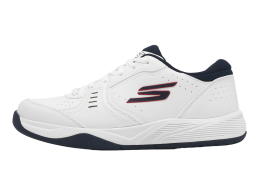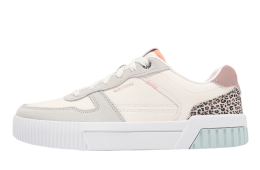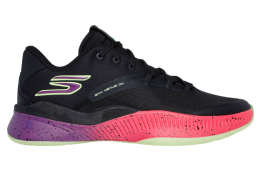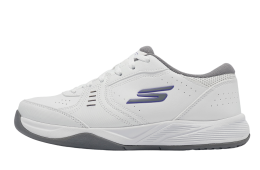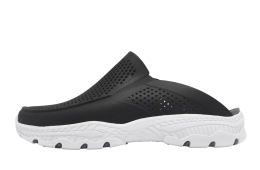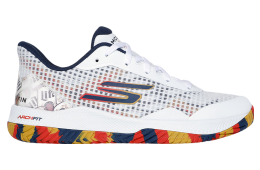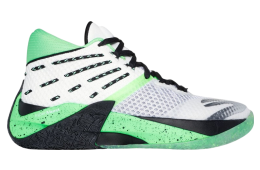Skechers
Skechers has established itself as a prominent brand in the sneaker market, offering a diverse range of footwear that caters to both athletic performance and everyday comfort. Known for their innovative approach to design, Skechers sneakers often feature technologies such as Memory Foam insoles, which adapt to the contours of the foot for personalized cushioning and support. This emphasis on comfort is complemented by lightweight constructions and flexible outsoles, ensuring agility and ease of movement throughout the day.
Beyond comfort, Skechers sneakers come in a variety of styles to suit different preferences and activities, from slip-ons and lace-ups to specialized running shoes and lifestyle sneakers. Each style incorporates performance-driven features like Air-Cooled Memory Foam for enhanced breathability and Goga Mat technology for responsive cushioning, catering to both athletes and casual wearers alike. Whether for sports, leisure, or daily activities, Skechers continues to innovate with footwear that blends functionality, style, and comfort, appealing to a broad spectrum of consumers seeking reliable footwear solutions.
read moreHistory of Skechers
The History of Skechers
Skechers, an American footwear company renowned for its diverse range of shoes, has grown to become a global brand. Its trajectory from a small startup to a significant player in the footwear industry is a compelling story of vision, innovation, and strategic growth. This history chronicles the journey of Skechers over the years, from its inception in the early 1990s to its present status.
Founding and Early Years (1992-1999)
Skechers was founded in 1992 by Robert Greenberg and his son Michael Greenberg. Before Skechers, Robert Greenberg had already made a mark in the footwear industry with L.A. Gear, a brand famous for its fashion athletic footwear. However, after parting ways with L.A. Gear, the Greenbergs sought to create a new brand that would cater to the needs of a different demographic.
Initially, Skechers started as a distributor for Dr. Martens shoes. Recognizing the growing trend for casual and streetwear styles among young adults, the Greenbergs decided to transition from being a distributor to a manufacturer. Their first product was the "Chrome Dome," a logger boot that immediately resonated with the market due to its rugged and stylish design. This success cemented Skechers’ commitment to focusing on casual footwear.
By the late 1990s, Skechers had expanded its product line to include casual shoes, dress shoes, and a wider variety of boots. The company's marketing strategy focused heavily on appealing to a youthful demographic, employing edgy advertising campaigns and sponsorships with up-and-coming celebrities and athletes.
Growth and Expansion (2000-2009)
The turn of the millennium marked a period of rapid growth and expansion for Skechers. The company went public in 1999, which provided the capital necessary for further expansion. With the influx of funding, Skechers diversified its product range to include athletic shoes and performance-based footwear. This diversification was essential for competing with established giants like Nike and Adidas.
Skechers launched sub-brands to cater to various market segments. For instance, Skechers Sport was introduced to appeal to the athletic market, while Skechers USA targeted those looking for casual and trendy footwear. The children’s line, Skechers Kids, also gained popularity due to its vibrant designs and comfortable fit.
During this period, Skechers began to establish a global presence. The brand expanded to international markets, setting up subsidiaries and licensing agreements in various countries. By 2005, Skechers had a presence in over a hundred countries, enhancing its global footprint through retail stores and partnerships with local distributors.
Marketing continued to play a vital role in Skechers' strategy. The company’s campaigns often featured popular celebrities and athletes, which helped in building a strong brand identity. Notable endorsements during this period included pop star Britney Spears and American Idol winner Carrie Underwood, both of whom contributed to the brand's visibility and appeal.
Innovation and Challenges (2010-2015)
The early 2010s were characterized by significant innovation within the company. Skechers introduced the Shape-ups line in 2010, a collection of fitness shoes designed with a unique rocker bottom sole. These shoes were marketed heavily on the premise of enhancing fitness by promoting muscle activity and improving posture. Shape-ups became a blockbuster hit, propelling Skechers into the fitness market and boosting sales considerably.
Despite this success, Skechers faced challenges, particularly in the form of legal battles. In 2012, the company agreed to a $40 million settlement with the Federal Trade Commission (FTC) over claims that it had made unfounded health benefits assertions related to the Shape-ups line. This represented a significant setback, both financially and in terms of public perception.
Undeterred, Skechers continued to innovate. The company launched the Skechers GOrun line in 2012, a series of lightweight running shoes designed with input from elite athletes like marathoner Meb Keflezighi. The GOrun series was well-received and marked Skechers' successful entry into the performance running shoe market. Meb Keflezighi's victory at the 2014 Boston Marathon in Skechers GOrun shoes further strengthened the brand’s credibility in the athletic footwear segment.
Additionally, Skechers continued its tradition of celebrity endorsements. This period saw collaborations with notable figures such as Kim Kardashian and basketball legend Joe Montana, both of whom significantly contributed to the brand's marketing campaigns.
The Boom in Comfort Footwear (2016-Present)
As the demand for athleisure and comfort footwear surged in the mid-2010s, Skechers was ideally positioned to capitalize on this trend. The company introduced Memory Foam technology into its shoes, revolutionizing the comfort aspect of casual and athletic footwear. Memory Foam footwear quickly became a best-seller, favored for its superior comfort and cushioning.
In 2016, Skechers launched the Skechers Burst line, which featured advanced soles made from responsive, energy-returning materials. These shoes received high praise for their comfort, style, and affordability, solidifying Skechers' reputation as a go-to brand for everyday footwear.
Skechers also embraced sustainability, realizing that modern consumers value environmentally friendly products. The company introduced various initiatives to reduce its environmental impact, including using recycled materials in its shoe production and ensuring sustainable practices in its supply chain.
Marketing strategies continued to evolve, incorporating influential figures and leveraging social media. The brand's campaigns featured a mix of celebrities and athletes, including Camila Cabello, Tony Romo, and Joanna Krupa, highlighting the versatility and broad appeal of Skechers footwear.
International growth remained a focus. Skechers expanded significantly in markets such as China, India, and Europe, opening flagship stores and increasing its presence in major cities worldwide. The brand's emphasis on affordability, comfort, and style resonated well in diverse markets, driving global sales to new heights.
Strategic Collaborations and Community Engagement
Parallel to its product innovations, Skechers has also focused on strategic collaborations and community engagement. The Skechers Foundation, established as part of the company's philanthropic efforts, has been instrumental in contributing to various charitable causes. One of its notable initiatives, the annual Skechers Pier to Pier Friendship Walk, raises funds for children with special needs and education.
In terms of collaborations, Skechers teamed up with well-known brands and designers to create limited-edition collections. These collaborations helped to keep the brand fresh and exciting, appealing to both new and loyal customers. For instance, partnerships with artist Mark Nason resulted in stylish, high-end collections that attracted fashion-conscious consumers.
Understanding the importance of e-commerce, Skechers invested in enhancing its online presence. The company launched user-friendly websites and mobile apps to cater to the growing trend of online shopping. By 2020, e-commerce had become a significant revenue stream for the company, complemented by digital marketing strategies that targeted consumers more effectively.
Adapting to Changing Markets
As consumer preferences evolved, Skechers continued to adapt by innovating its product lines and entering new market segments. The demand for sustainable and ethical products led Skechers to develop eco-friendly footwear lines, featuring materials like organic cotton and recycled polyester. These products not only appealed to environmentally conscious consumers but also demonstrated the company's commitment to sustainability.
The rise of digital health and wearable technology provided another opportunity for Skechers. The company began exploring the integration of smart technology into its footwear, such as shoes that could track fitness metrics or provide comfort enhancements through advanced design. These innovations aimed to provide additional value to the consumer, blending the best of fashion, comfort, and technology.
Impact of the COVID-19 Pandemic
The COVID-19 pandemic posed significant challenges for the retail industry, and Skechers was no exception. With lockdowns and social distancing measures in place, foot traffic to brick-and-mortar stores plummeted. However, Skechers' strong e-commerce infrastructure helped mitigate some of the impact. The company bolstered its online sales channels, offering virtual fittings and enhanced customer service to cater to home-bound customers.
Despite the challenges, the pandemic also increased the demand for casual and comfortable footwear as people spent more time at home. Skechers capitalized on this trend, with products like casual slip-ons and relaxation footwear seeing increased sales. The company also focused on ensuring the safety of its employees and customers, implementing health protocols across its operations.
Recent Developments and Future Prospects
By the early 2020s, Skechers had firmly established itself as a leader in the global footwear market. The company continued to innovate in product design, incorporating the latest trends and technologies into its offerings. With a robust supply chain, strategic collaborations, and strong marketing campaigns, Skechers maintained its competitive edge in a crowded market.
Looking forward, Skechers aims to further expand its global footprint, particularly in emerging markets where the demand for affordable and comfortable footwear is high. The company also plans to enhance its e-commerce capabilities, leveraging data analytics and artificial intelligence to provide personalized shopping experiences for consumers.
Sustainability remains a key focus, with ongoing efforts to reduce the environmental impact of its operations. Skechers is committed to exploring new materials and processes that minimize waste and energy consumption, aligning with the global push towards more sustainable business practices.
Conclusion
The history of Skechers is one of ingenuity, resilience, and growth. From its humble beginnings as a distributor to becoming a global powerhouse in the footwear industry, Skechers has navigated market trends, consumer preferences, and industry challenges with remarkable agility. Through continuous innovation, strategic marketing, and a commitment to comfort and style, Skechers has carved out a unique space in the hearts and minds of consumers worldwide. As it looks to the future, Skechers is well-positioned to continue its legacy of creating footwear that resonates with people from all walks of life.

